Shikoku Temple Trek 1
Hiking Temple to Temple in the Lost Japan

Printable version of trip itinerary
Shikoku 88 Temple Pilgrimage Slide Show
Shikoku 88 Temple Pilgrimage Slide Show for iPad and iPhone
Shikoku Temple Trek Trip Comparison and FAQs
Traveling in Japan in 2025: What to Expect

Be sure to watch the Shikoku Pilgrimage episode of the six-part PBS documentary series, Sacred Journeys. The episode on the Shikoku Pilgrimage, which features the group from the 2013 Mountain Hiking Holidays Shikoku Pilgrimage Trek, aired on December 16, 2014 on most PBS stations in the U.S. The DVD of the Sacred Journeys series is available at the Shop PBS website. Or, you can watch the episode on iTunes; search the iTunes Store for “Sacred Journeys Shikoku.” Consider joining us on this trip to experience the pilgrimage for yourself!
You might also be interested in Shikoku Temple Trek 2 and Shikoku Temple Trek 3.
The 88 Temple pilgrimage is an eleven-hundred-year-old, 800 mile-long route that encircles the Japanese island of Shikoku, the smallest of Japan’s four principal islands. The route links the sacred sites associated with the ninth century, Shikoku-born Buddhist monk, Kūkai, who after death became known as Kōbō Daishi (“dharma master”)—a figure much revered in Japan for his wisdom and benevolence. The route of this pilgrimage has been followed by pilgrims for over a millennium. It’s a Japanese “Camino de Santiago” undertaken in whole or in part by thousands of pilgrims (known as henro) each year. Shikoku provides the finest of backdrops for the pilgrimage. The island is the epitome of the “old Japan,” the “off-the-beaten-path Japan”—a Japan that has in many ways been “lost” beneath the bustle of its ultra-modern cities like Tokyo, hundreds of miles away. It’s an island full of natural and cultural landscapes right out of a Japanese storybook, as one writer put it.
Join us to explore this ancient pilgrimage route on foot following in the footsteps of Kōbō Daishi during the cherry blossom season. Enjoy hiking mixed with architecture, food, village life, and perhaps even the prospect of personal enlightenment! You’ll hike the best, most beautiful segments of the 88 Temple pilgrimage route. Be among the first to uncover an experience still largely unknown to travelers outside Japan. Along the way, you may feel the spirit of Kōbō Daishi with you as you walk, hence the pilgrimage’s motto, Dōgyō Ninin, (“we two, traveling together”).
Shikoku remains a mystery to the average Japanese. It’s even more mysterious to foreigners, who rarely venture this far off the beaten path.
–DON GEORGE, “Japan’s Past Perfect,” National Geographic Traveler, January/February 2012
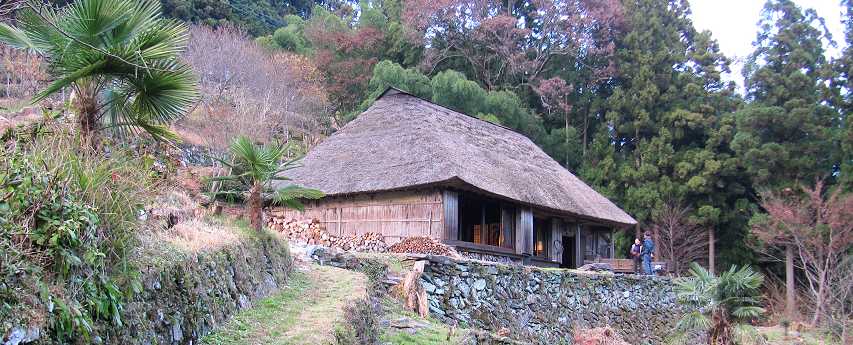
Day 1
Overnight in Tokushima
Breakfast, lunch and dinner included
Travel by vehicle to Ryozen-ji (Temple 1) from where the pilgrimage traditionally begins. It is said that Ryozen-ji was founded in the eighth century, but the current temple was rebuilt in the early 1960s. There is a shop at Ryozen-ji where pilgrims may purchase the accoutrements associated with the pilgrimage like the conical straw hat (sugegasa) and walking staff (kongozue). Hike from Ryozen-ji to Gokuraku-ji (Temple 2) with its red and white entrance gate, a beautiful garden of sculpted plants, and a thousand-year-old cedar tree. Continue on, passing fields where lotus root is grown, to reach Konsen-ji (Temple 3) and later the peaceful Dainichi-ji (Temple 4) surrounded by wooded hills. Finally, arrive at Jizo-ji (Temple 5) where today’s hike ends. Today’s hike covers a distance of about 8 miles with about 300 feet of elevation gain and loss; a shorter option is also available. From Jizo-ji, travel by vehicle back to your hotel in Tokushima.

A pilgrim arrives at Dainichi-ji (Temple 4)

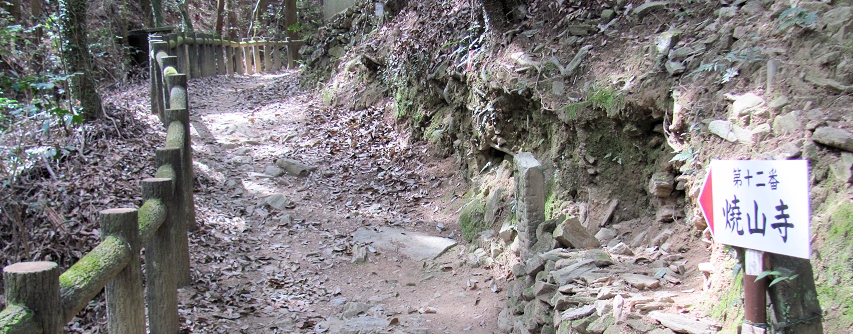
The pilgrimage trail leaving Fujidera (Temple 11); the sign points the way to Shosanji (Temple 12).
Day 2
Overnight in Tokushima
Breakfast and lunch included
Travel by vehicle from Tokushima to Fujiidera (Temple 11) also known as the Wisteria Temple. From Fujiidera, a challenging hike leads across the mountains to Shosan-ji (Temple 12) along a preserved section of the old pilgrimage route. You’ll encounter isolated springs, shrines and ancient Japanese cedar trees along the way. Shosan-ji (Burning Mountain Temple) is the first mountain temple on the 88 Temple circuit. Because of their locations, mountain temples on the pilgrimage are often referred to as nansho (“difficult place”). From Shosan-ji, return to Tokushima for the evening. The complete hike from Fujidera to Shosan-ji is about eight miles in length and involves a cumulative elevation gain of about 3,500 feet and a loss of about 1,300 feet. A shorter hiking option is also available.
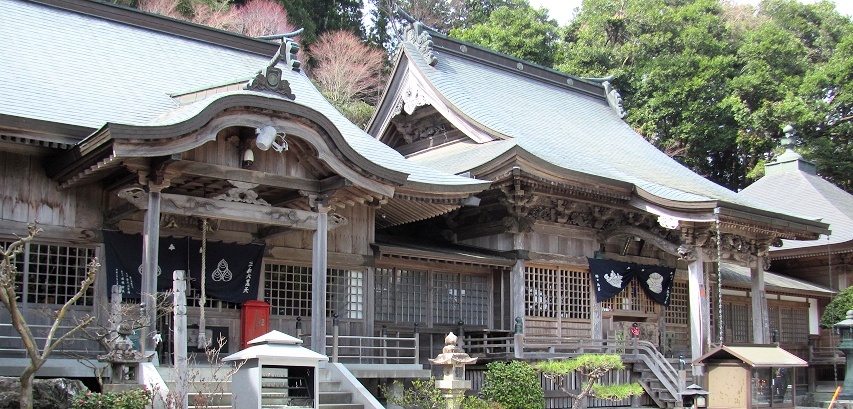
Shosanji (Temple 12), the first of the mountain temples on the pilgrimage route.

Finding your way on the pilgrim’s path: Route markers in various forms.

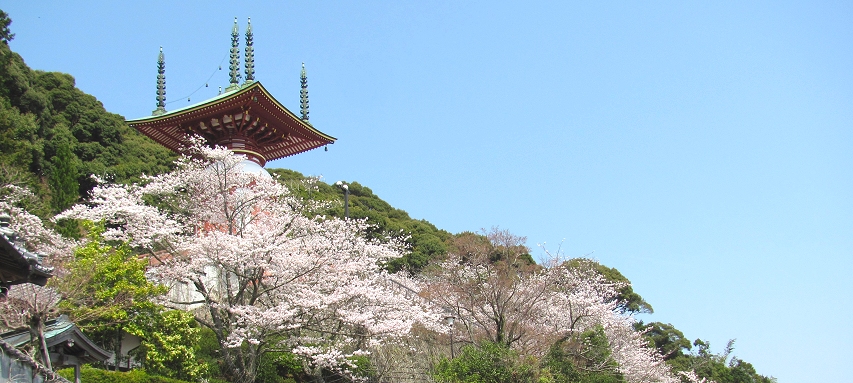
Yakuoji (Temple 23) and a cloud of cherry blossoms.
Day 3
Overnight at Nahari
Breakfast, lunch and dinner included
Transfer by vehicle to the coastal town of Hiwasa where you’ll visit Yakuo-ji (Temple 23)—one of the most popular temples on the entire pilgrimage route—with its striking red and white pagoda. From the temple’s hillside location you can enjoy the views of the town’s small reconstructed castle and the islands in Hiwasa Bay. After the temple visit, hike from Hiwasa Castle along Shikoku’s beautiful and rugged eastern coast full of rocky promontories, wave-dashed islets and sandy coves. This one-way hikes ends in the Kushigatani (valley) and covers a distance of 2.6 miles with about 800 feet of elevation gain and about 1,100 feet of elevation loss. Following the hike, travel by vehicle south along the seacoast to scenic Cape Muroto at Shikoku’s southeastern tip. At Cape Muroto, follow a trail that winds its way past coastal rock formations and tidal pools in the UNESCO-designated Muroto Geopark before ascending to Hotsumisakiji (Temple 24). Legend says that Kobo Daishi achieved enlightenment after spending three years in a cave below this temple. (The hike to Hotsumisakiji is about a mile and a half in length with an elevation gain of about five hundred feet.) Continue by vehicle to the fishing port of Nahari where you’ll spend the evening.
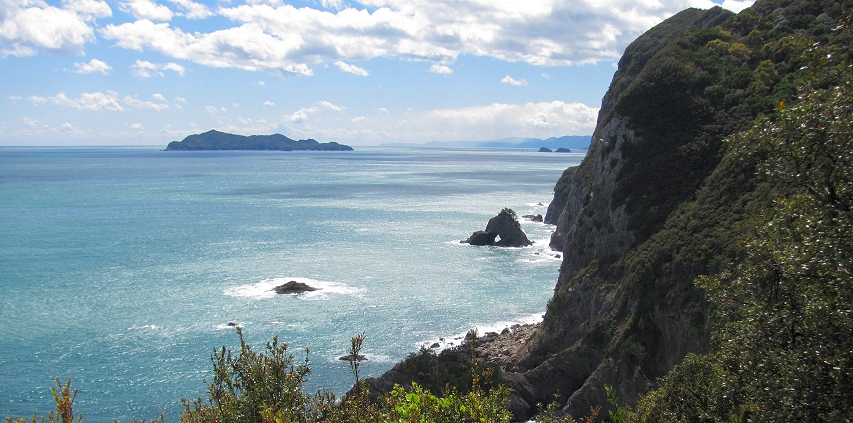
View of the Senba sea cliffs on the hike from Hiwasa–a fine example of Shikoku’s rugged coastline.

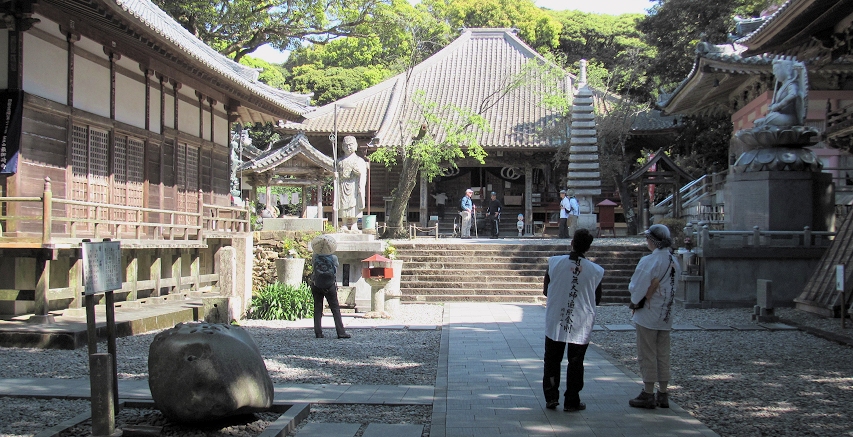
The temple of Hotsumisakiji (Temple 24) at Cape Muroto.
Day 4
Overnight in the Iya Valley
Breakfast, lunch and dinner included
This morning, travel by vehicle up the coast to the settlement of Yasuda from where you’ll begin the hike up to Kōnomineji (Temple 27). Like Shosanji, Kōnomineji, with its mountain-side location fourteen hundred feet above sea level, is considered a nansho temple. On the ascent to Kōnomineji, enjoy occasional views up and down the Shikoku coastline and enjoy woodlands ablaze with cherry and azalea blossoms. From Kōnomineji, descend via an alternate route to Toyama where the hike ends. (The hike to Kōnomineji is about six miles with about fifteen hundred feet of elevation gain and about twelve hundred feet of loss.) Continue by vehicle into central Shikoku’s Iya Valley, a remote area that some people have called “Japan’s Tibet.” Enjoy the next two evenings in a traditional ryokan with one of the best outdoor baths (rotenburo) on Shikoku!

Azaleas bloom in profusion along the path to Konomineji (Temple 27).

The pleasures of a picturesquely positioned rotenburo (outdoor hot spring bath) await you in the remote Iya Valley.


Pilgrims on the Sano Pilgrim Trail climbing to Unpenji.
Day 5
Overnight in the Iya Valley
Breakfast, lunch and dinner included
Travel by vehicle to the valley of the Umaji River and the trailhead for the Sano Pilgrim Trail, a portion of the pilgrimage route that ascends a forested ridge to reach Unpenji (Temple 66, “Hovering Cloud Temple”). Perched at an elevation of 3,060 feet above sea level, Unpenji is the highest temple on the pilgrimage route, and on a clear day the Seto Inland Sea, only six miles distant, sparkles in the sunshine. You can descend from Unpenji via the Unpenji ropeway (cable car), or for a longer hiking option, you can continue along the pilgrimage route following the trail as it descends into the Awai Valley where the hike ends. (The complete hike from the Umaji River to the Awai Valley covers a distance of about six miles and involves about 2,300 feet of elevation gain and loss.) Travel by vehicle back to your hotel in the Iya Valley and visit the nearby Iya Kazurabashi (vine bridge) before dinner.

Crossing the Okuiya Vine Bridge (kazurabashi) in the Iya Valley.

Day 6
Overnight in Matsuyama
Breakfast, lunch & dinner included
Depart the Iya Valley this morning and transfer by vehicle heading north through the Oboke Gorge before turning west toward Matsuyama, capital of Ehime prefecture. Today you’ll have the opportunity to complete the hike from Temple #46 (Joruri-ji) to Temple #51 (Ishite-ji). You’ll pass by six temples en route, plus the temple of Monjuin, one of the twenty other sacred temples (called bangai) that are found along the route of the 88 Temple Pilgrimage though not officially part of it. This is a delightful hike offering a variety of sights and sounds along the way. The complete hike is about in 8.5 miles in length with only a few hundred feet of elevation gain and loss. A shorter hiking option is also available.

Peaceful, forest-backed Hanta-ji (Temple 50) en route to Ishite-ji.

Matsuyama Castle (Matsuyama-jo), one of twelve feudal castles in Japan in their original state.
There is something magical about setting off on a pilgrimage of this nature. As you walk, the world reduces itself and things become more simple…you and your steps one in front of the other. You can’t help but think about all the others who, over the course of nine centuries, have passed this way before you.
–JOHN OSAKI writing in his blog

Long flights of steps lead up to the forest temple of Daihoji (Temple 44).
Day 7
Overnight Matsuyama
Breakfast and lunch included
Travel by vehicle from Matsuyama to the mountain plateau of Kuma Kogen (“Bear Plateau”) at an elevation of 1,600 feet above sea level. Start today’s hike at Daihoji (Temple 44) in a deep, beautiful forest setting. After visiting Daihoji, begin the hike to Temple 45 (Iwayaji). The trail ascends on a even grade to a low pass before dropping to reach the small village of Shimohatanokawa. The route continues through rural landscapes and woodlands before dropping gently into an isolated valley with a couple of small farmsteads. Ascend once again into the forested hills and follow the trail as it ambles along ridgetops before beginning a final descent to the enchantingly situated mountain temple of Iwayaji backed by sheer rock walls. After the hike, travel by vehicle back to Matsuyama for the evening.

On the pilgrimage path to Iwayaji (Temple 45).


The trail to Yokomineji (Temple 60).
Day 8
Overnight Takamatsu
Breakfast, lunch and dinner included
Today, hike the trail that leads up to Yokomine-ji (Temple 60), another nansho temple, often regarded as the temple with the most challenging access on the 88 Temple circuit. The trail climbs steadily and directly up the wooded hillside to reach Yokomine-ji. The origins of the temple date from the mid-seventh century at which time it was affiliated with the sacred mountain, Ishizuchi-san; it became a Buddhist temple in the mid-nineteenth century. From Yokomine-ji, the route descends via a different path to reach the lowlands at Kouon-ji (Temple 61) also known as the Incense Garden Temple. Though its origins date to the sixth century the main structures at Kouon-ji were recently rebuilt in a quite modern style so, visually, it stands in marked contrast from most of the temples on the pilgrimage route. From the end of the hike at Kouon-ji, travel by vehicle to Takamatsu, the principal city of Kagawa prefecture. The hike today covers about eight and a half miles and involves an elevation gain of about 1,800 feet and an elevation loss of about 2,500 feet. A shorter hiking option is also available.

Henro (pilgrims) hiking to Yokomineji.


A Nōkyōchō (Temple stamp book).
The Nōkyōchō (納経帳)
Most pilgrims carry with them a temple stamp book called a nōkyōchō. At each temple office, you can have someone stamp your book with the vermilion stamps bearing the temple’s name. Then, using a calligraphy brush, symbols representing the main deity of the temple are handwritten in your book. You pay about 500 yen to have someone enter these in your nōkyōchō. You can purchase a nōkyōchō at just about any temple for about 2,000 to 3,000 yen depending on how elaborate you want your book to be. The nōkyōchō pictured here was made specifically for the Shikoku pilgrimage; there is a page for each of the 88 temples on the pilgrimage route. The stamps in your nōkyōchō serve as evidence that you have visited the temples, so they’re similar to passport stamps, and they make memorable souvenirs!


Enjoy temple grounds bursting with cherry blossoms. Here, the grounds of Temple 2 (Gokurakuji).

Day 9
Overnight Takamatsu
Breakfast, lunch and dinner included
From Takamatsu, travel by vehicle to Nagao-ji (Temple 87) from where you’ll begin the hike to Okuboji (Temple 88). From Nagaoji, the route heads south passing well-tended fields before climbing steeply over the wooded summit of Nyotai-san to reach Okuboji, the Temple of the Large Hollow, set in a quiet highland valley. An alternate, less challenging route to Okuboji that follows the course of the Makigawa (river) rather than climbing over Nyotai-san is also a possibility. Since it’s the last of the 88 temples, Okuboji is also known as the the Temple of the Completion of the Vow. From Okuboji, travel by vehicle back to Takamatsu where you’ll overnight and celebrate the conclusion of your journey. The complete hike from Nagaoji to Okuboji (via Nyotai-san) covers a distance of about eight miles and involves an elevation gain of about 2,800 feet and an elevation loss of about 1,200 feet. Shorter, less strenuous hiking options are also available. Your breakfast tomorrow morning is included in the trip price.

Statue of Kobo Daishi at Jodo-ji, Ehime prefecture.

Printable version of trip itinerary
Shikoku 88 Temple Pilgrimage Slide Show
Shikoku 88 Temple Pilgrimage Slide Show for iPad and iPhone
Shikoku Temple Trek Trip Comparison and FAQs
Traveling in Japan in 2025: What to Expect


Photos on this page are by John Osaki (© All Rights Reserved) except as otherwise credited.








